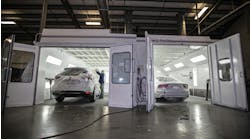Six things you’re too busy to do that are costing you
Let me tell you about my friend John. John is a shop owner. He’s doing pretty well right now. His shop is always busy. His technicians are maxed out, but he won’t hire another tech because he knows when they get slammed, he can step in and get the work done — which he does almost daily. It takes him longer because he has to stop and deal with employees and customers, so he stays late and works weekends when needed. John also won’t hire a customer service rep to help his service advisor because he can do that role, too. John is also the go-to person to pick up parts at the dealer and give customers a ride to work. As a result, he often forgets to get things done on time like reporting his bookkeeping to the accountant, returning phone calls and following up with customers to make sure they are happy with their experience.
Even though John is very busy, there are a lot of things he should be doing that are not getting done. Does this sound like you? Are you the shop owner trying to be the back-up technician, assistant service advisor, parts runner, shuttle driver and janitor? The hard truth is that is those roles are NOT yours to fill. You may think you are saving money by trying to do it all — but the things you’re not doing are the ones that give you the greatest return on the investment of your time. Your focus should be on the duties only the shop owner can perform. And when you don’t get those done, it costs you a lot of money.
Limited Time Offer: Time Is Money Calculator
To find out how much your time is worth, for a limited time, request ATI’s Time Is Money Calculator at www.ationlinetraining.com/2021-02
Opportunity cost is the loss of other alternatives when one alternative is chosen. There is an opportunity cost to every choice we make. If we choose to eat fast food for lunch vs. packing healthy leftovers, the opportunity cost is money, nutrition, overall health, weight loss and time we could spend doing something else. If you choose to be the back-up tech instead of the owner, you lose out on what you would gain if you worked ON your shop instead of IN it.
There are six key areas you should be focusing the majority (80 percent to 90 percent) of your time on and an opportunity cost (what you lose) when you choose to spend your time on other things:
Vision and strategy
A vision is a detailed image of the future. What do you want the future to look like? Who is your ideal customer? What do they look like, sound like, what hobbies do they have? What will be your reputation with customers and the community? The strategy is the plan for how you are going to achieve the vision. How does the shop navigate to achieve the vision? People want to work for a leader who gives them a higher purpose; they want to do business with companies that have a positive impact on the community. Opportunity Cost: Lacking vision and strategy can cost you profit, a good reputation and happy employees. If you’re not taking time to develop a vision statement and the strategy to bring it to fruition, you’re likely to lose highly skilled technicians and service advisors, assuming you have the time or money to hire them in the first place. It can cost you millions of dollars in sales over the course of time.
Processes and procedures
Your vision and strategy create the WHY for certain things that should be done in your shop. Your processes and procedures create the HOW. By clearly writing out and defining how you want things done, you build the same great experience for every customer and increase your retention rate and the lifetime revenue from each customer.Opportunity Cost: Sales, productivity, net profit. Lacking written processes and procedures significantly increases training time for new employees. Longer onboarding means higher payroll expenses before productivity starts. When processes and procedures are not defined, profit-killing mistakes occur at a higher rate and additional time is required to deal with customer service complaints and personnel issues.
Human resources and culture
Establishing who you want on your team, what roles each person plays and how you want employees to interact with one another determines the culture in your shop. A high-performance team has a positive attitude, works well together and results in the longevity of employees and higher productivity. But it doesn’t happen accidentally. You must devote time to creating a culture that people want to be a part of.Opportunity Cost: Reputation, sales, net profit. Hiring the wrong person because you’re desperate and haphazardly hoping everyone gets along are costly mistakes that I see shop owners make every day. The wrong service advisor will result in lost sales and negative reviews. A technician who refuses to do courtesy checks will damage your team atmosphere and cause customer service issues.
Accounting and finances
As the shop owner, it’s your responsibility to keep the shop financially healthy. That includes understanding and keeping a close eye on inventory, payroll, A/R, A/P, operating expenses, taxes, KPIs — and the list goes on.Opportunity Cost: Net profit. The No. 1 reason shops go out of business is the failure of the owner to pay attention to what is going on in their business financially. Knowing and understanding your financial data gives you the power to make decisions on hiring, adding services, training and marketing. It’s the best way to diagnose where you are making a profit and where you are losing money or leaving money on the table.
Marketing and advertising
This includes how customers see you, how employees see you and how the community sees you. Whether you do your marketing in house or hire a company to do it for you, it is still your responsibility to make sure the image being presented is what you want, and that you are attracting new and returning customers from those efforts.
Opportunity Cost: New customers, returning customers, great employees, reputation, sales, net profit. Failing to maintain a consistent, effective marketing plan will make it harder for potential customers to find you and reduces repairs and maintenance to an afterthought for customers. The most effective way to keep car count steady and reliable throughout the year is great marketing combined with the vigilant pursuit of exceptional customer service.
Legal issues
This includes reviewing your insurances, workers comp, safety/OSHA requirements, tax liabilities and corporate structure as you grow. Building a great relationship with an accountant and an insurance broker who specializes in the auto repair industry will not only save you money but may save your business if you get in trouble.Opportunity Cost: Net profit. As the owner, you are responsible for the legal burdens of your shop; these cannot be delegated, and you cannot afford to ignore them. Policy reviews every year guarantee you are paying a reasonable and fair amount for your various insurances and that you have sufficient and appropriate protection. Failing to address safety concerns, provide training and have appropriate Worker’s Comp insurance can and do result in businesses closing when a serious injury occurs. And no one wants to face an overwhelming tax burden created by poor planning.
If you started your shop thinking that honest hard work and great mechanical skills were all you needed, it doesn’t take long to realize there is a lot more to owning a successful, profitable shop. Finding time to focus on these areas will help you build the auto repair shop of your dreams and a team ready to help you get there.
To get refocused and find out how much your time is worth, request ATI’s Time is Money Calculator at www.ationlinetraining.com/2021-02.




